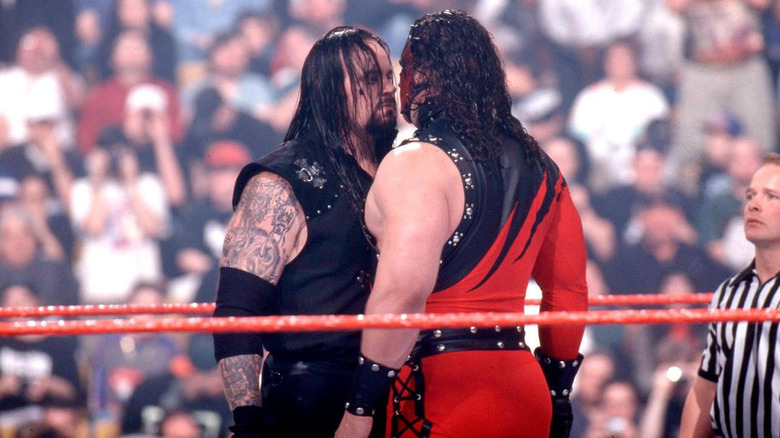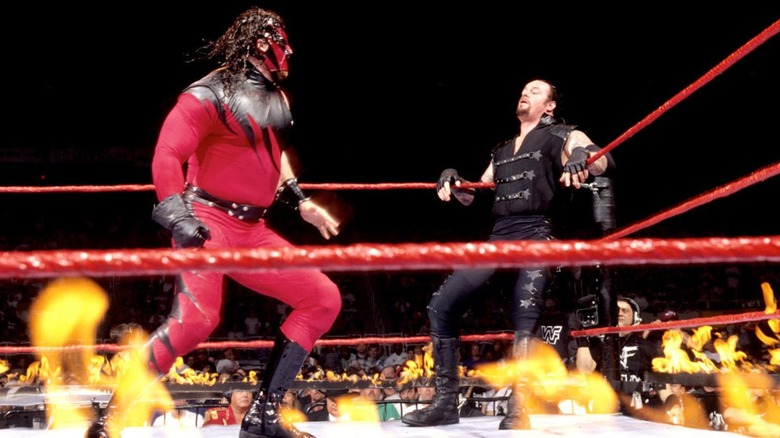WWE Hall Of Famer Jim Ross On The Undertaker's Pivotal Role In Getting Kane Over
After nearly five months of Paul Bearer threatening to reveal Undertaker's "deepest, darkest secret" to the world, Kane finally arrived at Badd Blood: In Your House on October 5, 1997, costing his kayfabe brother the inaugural Hell in a Cell match against Shawn Michaels. The fact that WWE waited that long to debut Kane is the perfect example of long-term storytelling — an art form, that, many believe is rarely found in modern wrestling.
On the latest "Grilling JR," Ross explained why WWE didn't want to rush Kane's arrival after airing vignettes months prior to "The Big Red Machine's" debut. "It was a matter of not force-feeding Kane to the audience," Ross said. "It was very strategic booking — I thought it was done correctly. In hindsight, I couldn't have booked it any better than it was. It was easy to get into, an easy story to tell, and right on point." Ross credited Undertaker for taking such an ownership stage in the Kane saga coming to fruition and the countless hours he spent with WWE's creative team to get every nuance perfectly right.
"A lot of 'Taker's fingerprints were all over this storyline," Ross revealed. "He had a vested interest in it, he knew where it was going, and he knew what he needed to do to make it happen — and he did everything he needed to do. Undertaker was very, very ... he had the ability to share. A lot of the top talents would not give so much of themselves because they were insecure. 'Taker was not insecure and he knew that Glenn [Jacobs] was a keeper of this deal," added Ross, revealing that Undertaker taking a liking to Kane backstage certainly helped with his personal involvement in the storyline.
'Taker was the guy that had the visual ideas'
Considering that so much of Kane's persona was reliant on presentation, The Undertaker also collaborated with WWE's production team to further speed up the development of the debuting character, according to Ross. Similarly, Undertaker was instrumental in putting together gimmick matches such as The Inferno Match and The Buried Alive Match that became calling cards for Kane in subsequent years.
"'Taker was the guy that had the visual ideas," Ross revealed. "[The visuals] were striking and so memorable — another booking hit for 'Taker if nothing else. Because you can bet your ass he's gonna be deeply involved in the creative of getting buried alive or burned alive."
As part of the strategic booking to introduce Kane to the audiences, WWE was also extra careful in the number of matches he wrestled in his first year. Following his debut against Mankind at Survivor Series 1997, Kane did not wrestle again on television until No Way Out in February 1998 — ahead of his much-awaited clash against Undertaker at WrestleMania 14. In the lead-up to the brother vs. brother match, WWE shot an angle that saw Undertaker rise up from a coffin struck by a lightning bolt, furiously challenging Kane to a match in the process. Reflecting on the same, Ross acknowledged the importance of those visual effects in furthering the sibling story.
"It fit the Undertaker's character," Ross said of WWE's use of special effects for "The Deadman." "He's supposed to do the unknown and the unpredictable, so it just kept fitting; creative just kept fitting. Credit to the guys involved in doing it. I've spoken so much about 'Taker here, but when you've got a star like him, he's got to cooperate, he's got to be involved and invested — and he was. That's what made this thing successful."

